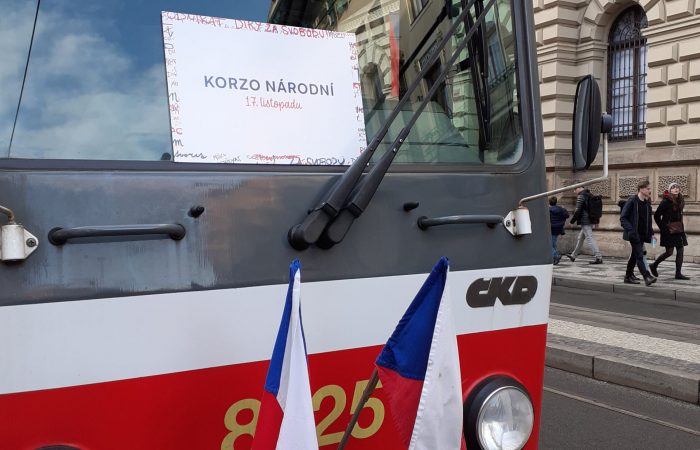
Socialism Realised and the 1989 in Czechoslovakia
November 22, 20192019 is of particular importance for many countries in Central and Eastern Europe. This year, it has been 30 years since the then-state socialist countries began overthrowing their communist governments and the Eastern Bloc started falling apart. As this process took a different form in each country, each nation fondly remembers its own memorable event that represents the 1989 revolution. For Germans, it is the fall of the Berlin wall. For Czechs and Slovaks, it is the 17th of November. On this date 30 years ago, the state police violently suppressed a peaceful students’ march on Prague’s Národní třída (National Avenue). The public got outraged and the revolution kicked itself off.
30 years have passed since then. It’s a long time; three decades usually represents the time of a generation. Hence, the 17th November 2019 wasn’t only a moment of commemoration, but also an opportunity to look back over the past 30 years.
The events of the 17th November were hugely commemorated this year. One of the main events took place at the very place where students and police clashed on Národní třída. The street was closed off to traffic, and many cultural and commemorative events took place there. ÚSTR and our team were also part of this. We took advantage of our presence there and decided to tell the story of the 17th November with the help of this very website: Socialism Realised.
Our intention wasn’t to just retell the story of the events that were the reason for all of the commemoration activities, but also to provide people with the opportunity to look back and review the recent past.

Since inquiry-based learning defines our approach, we started by just reminding people what the 17th November represents for Czech society nowadays and how it is perceived. Footage of clashes between unarmed and peaceful civilians on one hand and the repressive forces on the other sums up most of the 1989 events. Moreover, they provide a general idea of what was at stake back then. For this purpose, we used the Here when We Need Them and One-sided Fight videos. The advantage of these sources is that they don’t need much additional commentary, since they clearly represent the unequality between the two sides.
We further developed the spirit of those revolutionary days with the We Are Not Children! video. Here, the communist officials stand above the protesters, talk in a form of party jargon that’s hardly understandable today, and call the student protesters “children.” But the people in the street below — workers from a large machine factory — don’t identify with the party anymore. Instead, they take offense at the party official calling the students children, and, in a moment of identification with the students, they start shouting “we are not children!” An iconic video with a clear message. The nation is divided between clumsy officials and brutal task forces — the communists — and the rest, students, workers, and people beaten in the street, who want nothing but their freedoms.
At this point, we decided to make the fine story of 1989 a bit more complicated. Thus, we screened the video from The Kid and the Housekeeper. It depicts a random conflict that took place in the streets of Prague in 1989 — not between the police and civilians, but between regular citizens themselves. An old lady who calls herself a housekeeper argues with young students, disagreeing on their interpretations of the Czechoslovak past (the interwar Republic, the communist coup d’etat in 1948, and the Soviet invasion in 1968). The housekeeper insists on one question: “What do you want?” The youths’ answer is concise: “Freedom!” “But what freedom?”, housekeeper continues, but she is drowned out by shouting in the street.
Her conservatism can be seen as somewhat problematic today, but the unanswered questions remains. What freedom did the young men want? The one with the free press, private ownership, freedom to travel? Or the one where climatic crisis is looming, or where many media organizations are owned just by the people who can afford to buy them?

We concluded our lecture with one more video, once more adding some confusion to the seemingly black-and-white events of 1989. The footage from Revolution in the Regions shows students who left Prague to spread information about the unjust suppression of the November 17th march. In the video, they talk with miners in the North Bohemian regions (who were venerated as highly as factory workers in communist propaganda). But the miners’ reaction is somewhat mixed. They avoid the students and are at best mild in their support — and at worst, rather hostile. One gentleman claims that the police should have been even tougher on Národní třída … In other words, the initially presented dichotomy between state power — clumsy, armed, brutal — and the people appears to be more complicated. Obviously, there were rifts between the regular people as well. Such perspectives contest the prevailing image of the Velvet Revolution (of “us against them”) and leave us only with more questions. If the support wasn’t unanimous, what is the “defeated” party doing today? What have these people been doing for the past 30 years? And eventually, shouldn’t we try to offer a more nuanced picture of 1989?
We left our audience with questions, but the rest of the commemorative events could hopefully offer them some answers.
